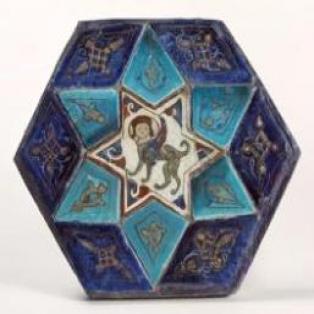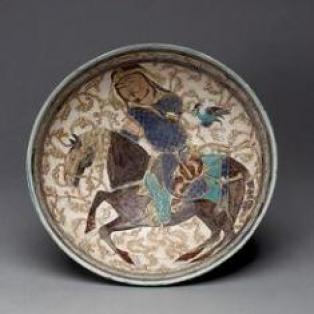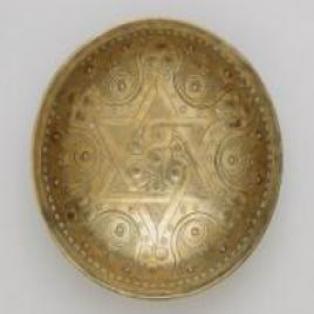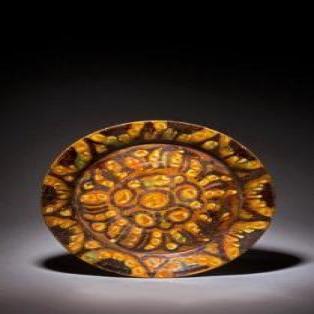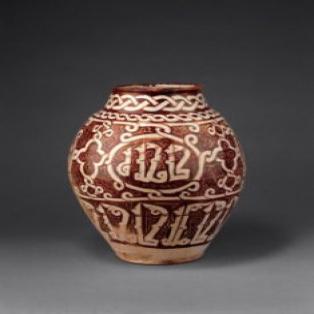Nasir-i Khusraw's Travels
ABBASIDS ( 750 - 1258 CE )
FATIMIDS ( 909 - 1171 CE )
GHAZNAVIDS ( 977 - 1186 CE )
GREAT SELJUKS ( 1038 - 1194 CE )
ANATOLIAN SELJUKS ( 1081 - 1308 CE )
Glazed tile, probably Konya, Turkey. Seljuks 6th-7th AH / 12th-13th CE century. Image courtesy: The Metropolitan Museum of Art.
The Anatolian Seljuks, also known as Seljuks of Rum (r. 474 - 708 AH / 1081 - 1308 CE) were the descendants of the Great Seljuks who ruled Persia, Syria and Anatolia.
The founding of the dynasty is credited to Suleyman b. Qutalmish I (d. 479 AH / 1086 CE), whose father, Qutalmish, was a cousin of the Seljuk rulers Chaghri (d. 452 AH / 1060 CE) and Tughril (d. 455 AH / 1063 CE). Suleyman challenged Alp Arslan (d. 464 AH / 1072 CE) for the Great Seljuk sultanate on the death of Tughril but was unsuccessful. In 471 AH / 1078 CE he conquered Iznik (Nicea) and established it as his capital. His son Qilij (r. 485-502 AH / 1092-1109 CE), upon his...
Read more
Bowl with prince on horseback, from Iran. Seljuk, 6th-7th AH /12th-13th CE century. Image courtesy: The Metropolitan Museum of Art.
The Great Seljuks (r. 429 - 590 AH / 1038 - 1194 CE) were a division of the Kiniq clan of Oghuz Turks, from the steppes north of the Aral Sea (lake in Central Asia). Initially, in the service of Qarakhanids of Transoxiana, they belonged to the leading tribe of the Oghuz Turks, and adopted Islam around 348 AH / 960 CE under their tribal leader named Seljuk.
The Seljuks came to reign over Afghanistan, Persia, Eastern Anatolia, Iraq, Syria, and on the Arabian Peninsula from 429-590 AH / 1038-1194 CE. Seljuk’s grandsons, Tughril (r. 429-455 AH / 1038-1063 CE) and Chaghri (r. 429-542 AH / 1038-1060 CE), divided the territory into Eastern-half...
Read more
High-tin bronze bowl from Afghanistan. Ghaznavid, 6th-7th AH / 12th-13th CE century. Image courtesy: The Metropolitan Museum of Art.
The Ghaznavids (r. 366 - 582 AH / 977 - 1186 CE) were men of Turkish slave origin who formed a dynasty in Afghanistan, Khurasan and northern India (r. 367-545 AH / 977-1150 CE), and reigned in Punjab until 582 AH / 1186 CE.
The origins of the Ghaznavids were in the middle-decades of the 4th AH / 10th CE century, when the Turkish slave commanders of the Samanids made themselves, in effect, autonomous in the cities of Bost and Ghazna, on the southern fringes of the Samanid territories. The Samanid commanders Alptegin (d. 364 AH / 975 CE) and his successor Sebuktegin (d. 387 AH / 997 CE), following their conquest of the town of Ghazna in 351...
Read more
Ceramic earthenware from Iran or Mesopotamia. Abbasid, 3rd AH / 9th CE century. Image courtesy: Aga Khan Museum.
The Abbasids (r. 132-656 AH / 750-1258 CE) were the third Muslim caliphate following the Umayyads and the four Rightly Guided Caliphs, al-khulafa al-rashidun. They succeeded the Umayyads around 132 AH / 750 CE as the caliphs of the (then) Muslim world.
Once in power, they began to persecute the Shi‘i Imams and their followers as the foundations of the Shi‘i Imamat are rooted in their claimed lineage from the family or house of the Prophet, the ahl al-bayt; a claim that the Abbasids had also made about themselves, tracing their lineage from Abbas b. Abd al-Muttalib, an uncle of the Prophet. Initially the Abbasids established themselves in...
Read more
Ceramic Jar, from Egypt or Syria. Fatimid, 6th AH / 12th CE Century. Image courtesy: Aga Khan Museum.
The Fatimids (r. 297-567 AH / 909-1171 CE) established themselves as the Shi‘a caliphate, countering the Abbasids in the 4th AH / 10th CE century. The Fatimids traced their lineage to the Prophet Muhammad through his cousin and son-in-law Ali b. Abi Talib, the first Shi‘i Imam, and his wife Fatima, the Prophet’s daughter.
The Fatimids were also acknowledged as the rightful Imams by the Shi‘a Ismailis not only within their own dominions, but also across many other Muslim lands.
Under the rule of the Fatimids, a dynamic and vibrant Muslim civilisation emerged in the ancient Mediterranean lands, first in North Africa (in the region known as...
Read more
